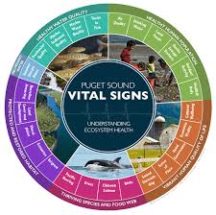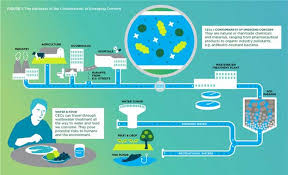Fixing the past and offering future opportunities
Toxics in fish. How did the toxics get there? What happens to fish and people when they are contaminated? How can we correct past mistakes and pave the way for future opportunities and increase community health? The Toxics in Fish Implementation Strategy is a roadmap for preventing, managing, and cleaning up a range of toxics in Puget Sound which affects fish and fish eaters.
The strategy’s development was led by the Stormwater Strategic Initiative Lead Team with a wide range of collaborators for which we are grateful.
The strategy, shorthand called “TIF”(for Toxics in Fish), is based on the Puget Sound Partnership’s Vital Signs program, indicators that are earmarks of how healthy the Puget Sound is.

Pollution Sources
The Toxics in Fish Vital Sign focuses on four chemicals or classes of chemicals: PCBs, PBDEs (Polybrominated diphenyl ethers– a flame retardant), chemicals of emerging concern (CECs) (such as pharmaceuticals and personal care products), and PAHs (polycyclic aromatic hydrocarbons, a combustion product from fossil fuels). The fish currently monitored for toxics include Pacific Herring (snacks for many other fish), English sole, Chinook Salmon, and Juvenile Chinook salmon (snacks for us and Orcas). The fish selection and chemicals we are focusing on may change over time.
These chemicals can come from electrical equipment and capacitors, caulks, and paints, driving with fossil fuel engines, and from evolving chemicals used as flame retardants. Others come from commonplace activities such as taking prescription medications, eating food with food additives, and buying products that contain chemicals that cannot be removed through wastewater treatment.

Academy of Finland
Industrial Economy Juxtaposed Against Opportunity
Our industry-led economy has resulted in massive inputs of toxic chemicals and other contaminants into Puget Sound since the dawn of the chemical revolution following World War II. With it came great conveniences but also legacy chemicals that are nearly impossible to clean up and have been present for half a century, which cause long-term harm to both people and fish/animals—PCBs are an example. That said, we now have incredible opportunities to use technology to change how products are made (green chemistry), and novel approaches that favor cost-effective redevelopment to protect these fish and the communities that eat them.
What does a rain garden, Orcas, and Chinook share in common?
The strategy also has important connections with Southern Resident Killer Whales (Orcas) and the recommendations of the Governor’s Orca Task Force— local resident Orcas eat Chinook salmon exclusively so by protecting Chinook, we give Orcas a chance to survive into the future. We are finding that simple solutions such as using rain gardens and bioretention can help clean water and prevent polluted stormwater from entering Puget Sound.

Courtesy of Washington Environmental Council GSI Photo Bank
Strategies
There are five strategies, two of which involve using incentives to swap out problematic materials like old electrical equipment and capacitors and making infill development easier and more cost-effective. Currently, it is cheaper to build on land we need to leave alone, “greenfields,” than it is to build on already developed land. Another two strategies are focused on cleaning up or mitigating areas of particular concern called “hotspots,” and accelerating clean up near water and in-water. The final strategy addresses how to prioritize and address chemicals of emerging concern. This latter strategy is the subject of research collaboration between Washington State University, University of Washington Tacoma, and other universities.
Please Comment by October 16th
The draft strategy is open for public comment until October 16th:
Please click here for instructions on how to provide comments and
links to the public review draft.
Comments on the Toxics in Fish strategy will be accepted through October 16th
Our partners
Washington Department of Ecology, Washington Department of Commerce, Washington State University Stormwater Center, Puget Sound Institute, Puget Sound Partnership, Washington Department of Fish and Wildlife, and Washington Environmental Council in collaboration with Toxics in Fish Interdisciplinary Team and Toxics in Fish Core Team.
Where to find the Toxics in Fish Implementation Strategy
The public review draft of the Implementation Strategy (split into several components) is located here: Toxics in Fish Implementation Strategy.
- Executive Summary: A brief description of the content within the implementation strategy narrative.
- Implementation Strategy Narrative: A report that describes strategies, approaches, and activities for managing contaminants.
- Appendices
- State of the Knowledge: An analysis that provides a scientific and technical foundation to the Toxics in Fish Implementation Strategy.
- Base Program Analysis: An analysis that describes the existing regulatory and programs that address issues related to managing toxic contaminants.
Questions
Email Lola Flores at [email protected]. Remember to share this opportunity with others you think might be interested.
A blog from Heidi Siegelbaum



